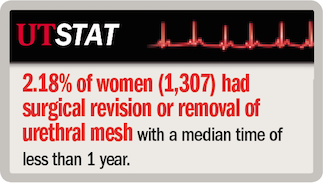Article
Low provider volume raises mesh removal risk
Author(s):
According to a population-based assessment of the risk factors for bladder slings used to treat stress urinary incontinence in women, provider volume impacts the incidence of mesh removal or revision.
New Orleans-According to a population-based assessment of the risk factors for bladder slings used to treat stress urinary incontinence (SUI) in women, provider volume impacts the incidence of mesh removal or revision.
The study, presented at the AUA annual meeting in New Orleans, also showed that having multiple mesh procedures was the highest risk factor for further complications.
Read: Long-term benefits observed with sling procedures
“Approximately 2% of women will need secondary surgery for removal or revision of a mesh SUI sling. There is a well-defined provider volume-outcome relationship for mesh SUI sling complications, as patients of low-volume providers have a 37% increased risk of mesh removal or revision,” said first author Blayne Welk, MD, of the division of urology at the University of Western Ontario, London, ON.
As Dr. Welk reported, stress incontinence surgery is a growth industry. Approximately one in seven women will undergo SUI surgery in their lifetime, and synthetic mesh, in the form of mid-urethral slings, accounts for almost 90% of these procedures.
NEXT: “While mid-urethral slings are obviously effective, they do have associated complications."
More from Urology Times:
Alpha-blocker may have benefit in larger stones
Weight-loss surgery may reduce incontinence
BPH counseling: Can you charge a level III visit?

Dr. Welk“While mid-urethral slings are obviously effective,” said Dr. Welk, “they do have associated complications. In the U.S., currently over 50,000 women have joined class-action lawsuits due to transvaginal mesh complications.”
In 2008, the FDA warned of “serious complications” associated with the procedure and advised that physicians obtain specialized training for each mesh technique. Dr. Welk and colleagues sought to evaluate these recommendations and determine specific characteristics of those patients at increased risk for complications.
Using administrative data from Ontario, Canada between 2002 and 2012, the authors included all adult women undergoing an initial SUI procedure with synthetic slings and excluded those with pelvic organ prolapse surgery involving synthetic materials.
“The primary exposure we were looking at was surgical volume. We defined a high-volume surgeon as being in the top 75th percentile of mesh-based SUI procedures in a given year,” said Dr. Welk.
Also see: Mid-urethral slings demonstrate efficacy, few adverse effects
The authors identified 59,877 women with a median age of 53 years. The median follow-up was 4.4 years.
According to Dr. Welk, 2.18% of women (1,307) had surgical revision or removal of urethral mesh with a median time of less than 1 year, and low-volume surgeons had a 37% increased risk of having a patient with one of these complications.
“You can see the absolute risk difference between the two groups was relatively small, but the significance of some of these complications still makes this an important statistic,” he indicated.
NEXT: Removal risk drops with increasing volume
Removal risk drops with increasing volume

While the vast majority of surgeons had very low procedure volumes over time, with increasing annual procedure volume, the risk of surgical revision or removal of the mesh decreases.
“Unfortunately, we can’t say that we, as urologists, are any better than gynecologists at performing this procedure. There is no statistically significant difference based on surgical specialty,” Dr. Welk said.
He also noted that he and his co-authors saw no significant difference in risk of complications for high-risk patients-those with a prior history of fistula, diverticulum, radiation, or urethral injury. Having multiple mesh procedures, on the other hand, was the highest risk factor for mesh complications, involving a fivefold increased hazard over time.
“I think that should be taken into account when we consider treatment of recurrent stress incontinence in these patients,” Dr. Welk concluded.
Have you read:
Blog - After the patient fall: How to save your back
Divorce: Understand the federal tax ramifications
MET found safe, efficacious in pregnant stone patients
Subscribe to Urology Times to get monthly news from the leading news source for urologists.
















